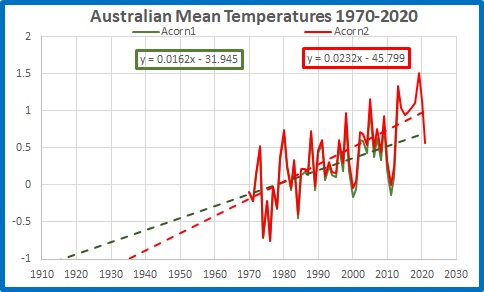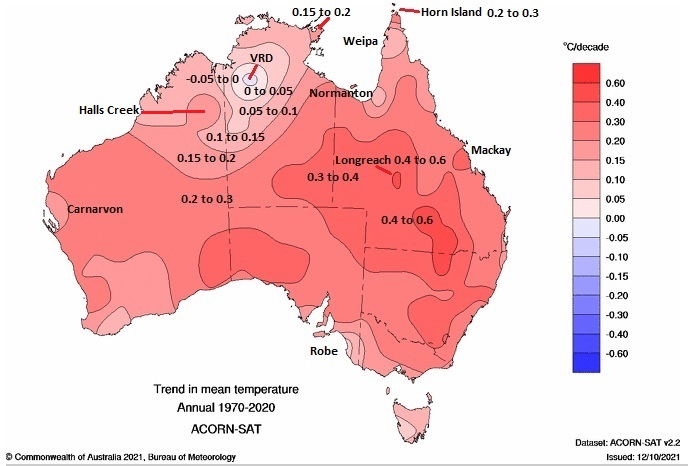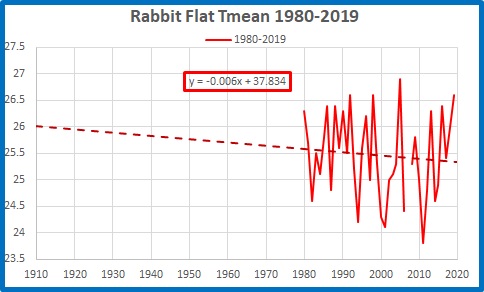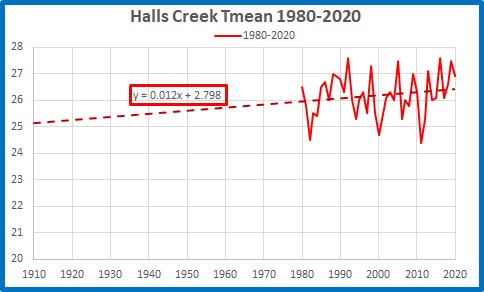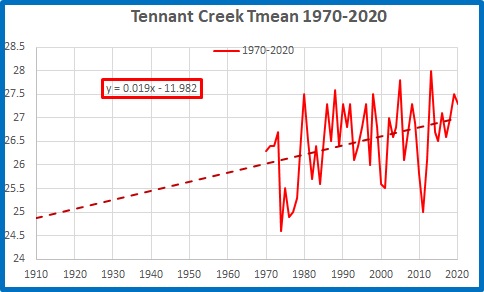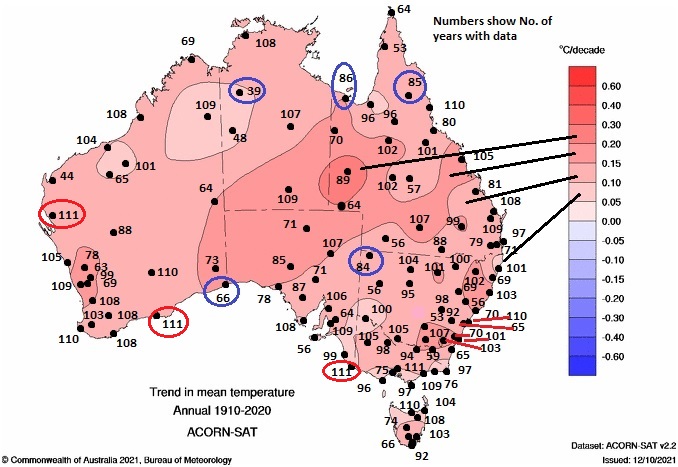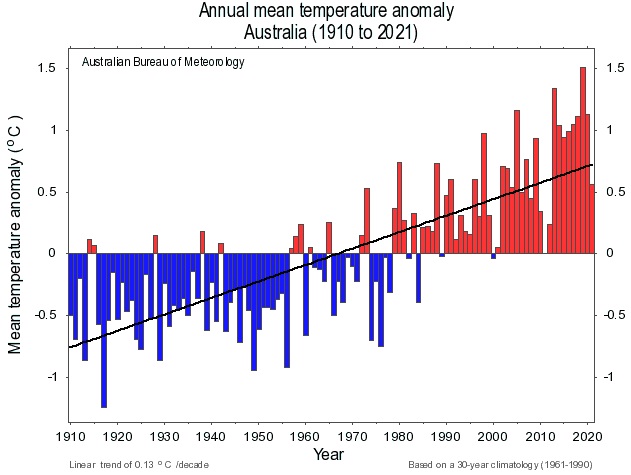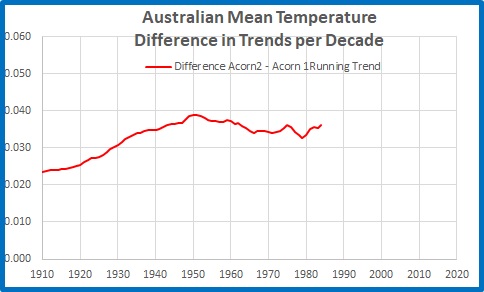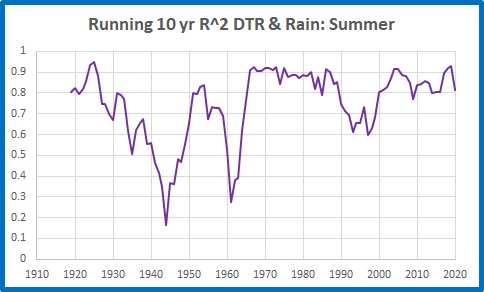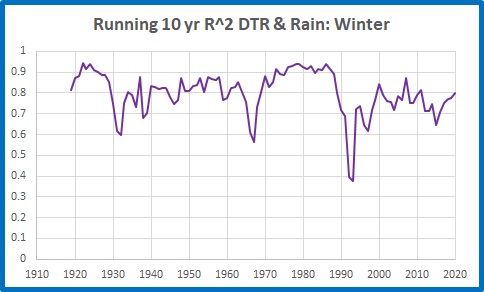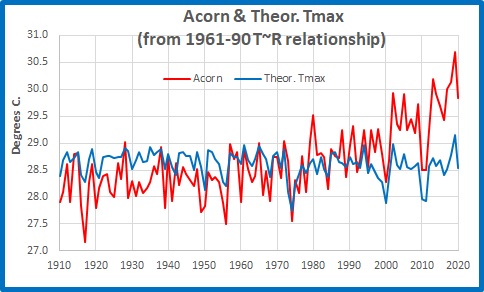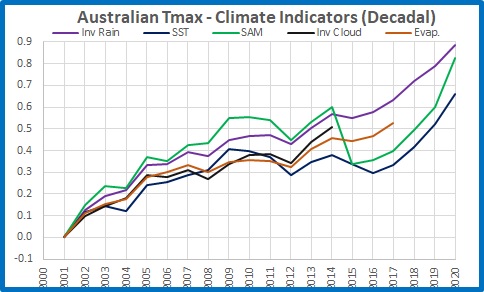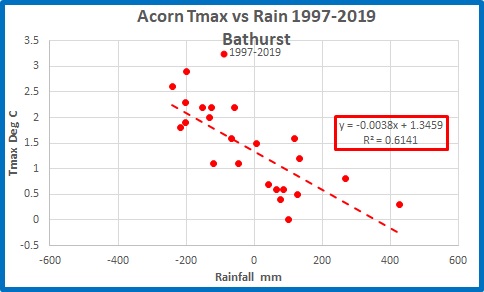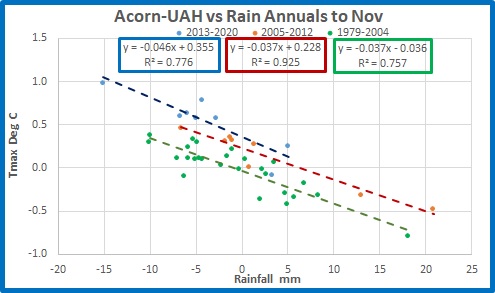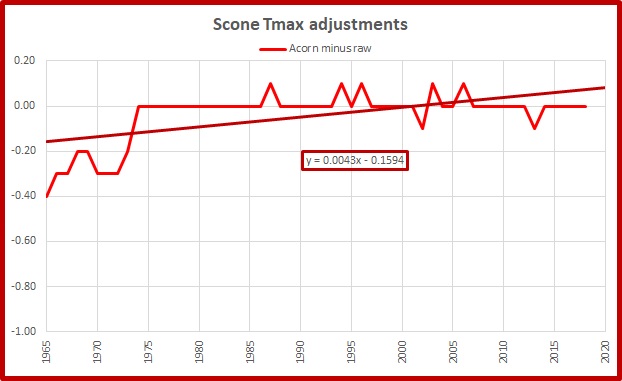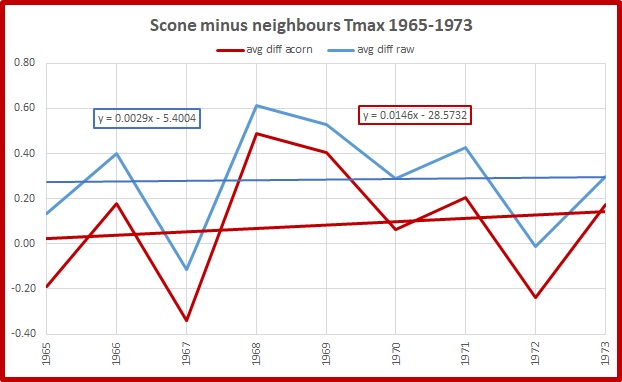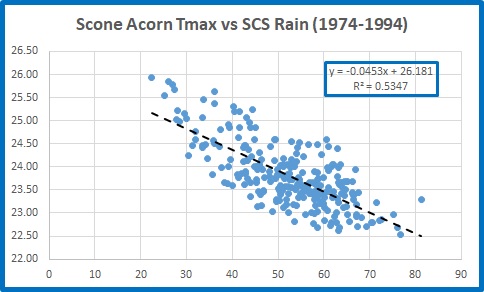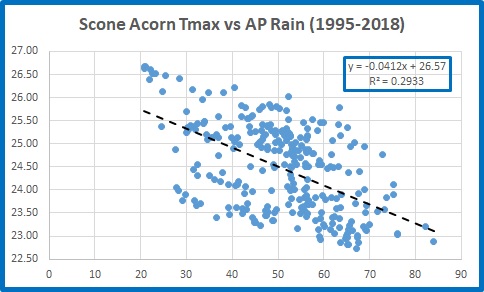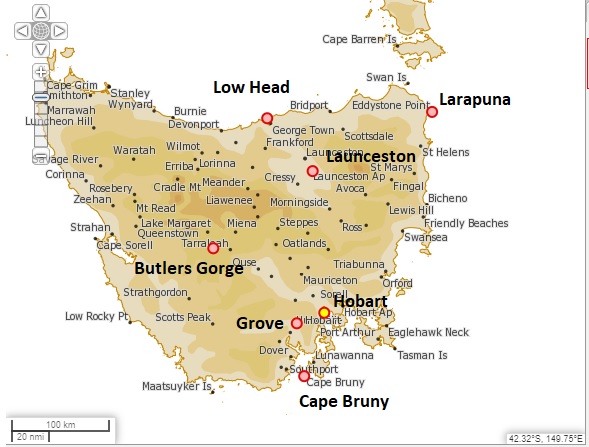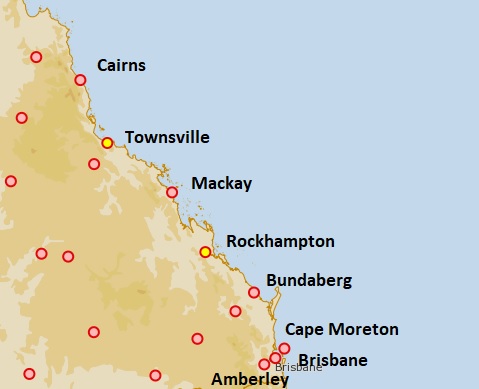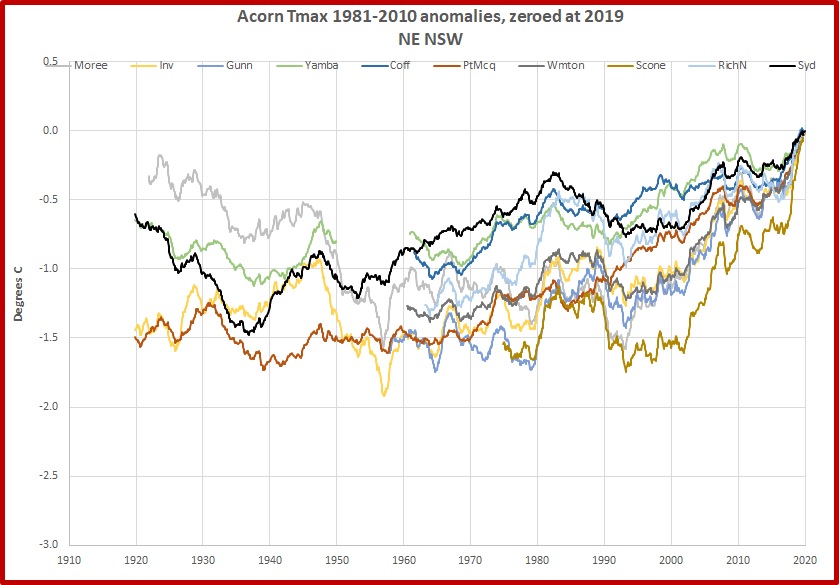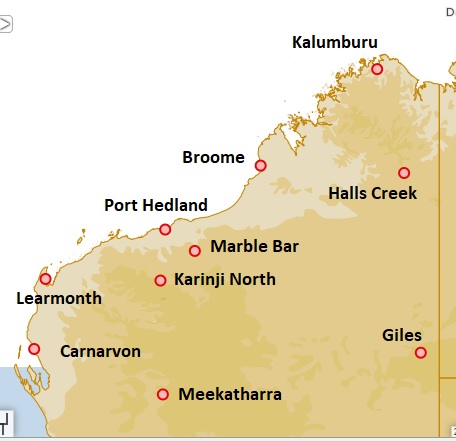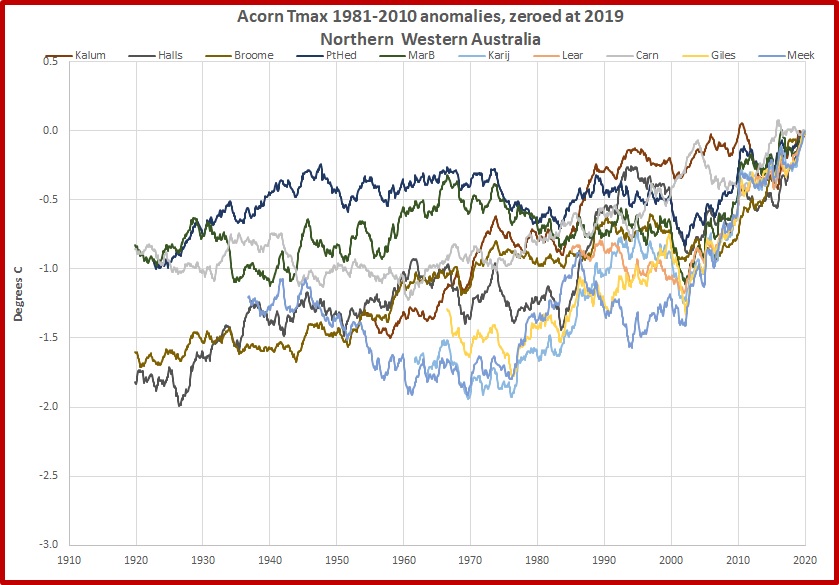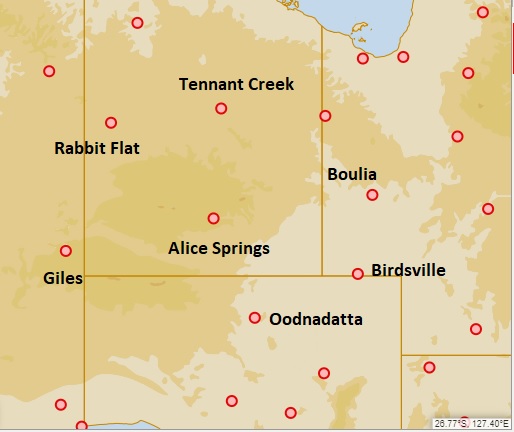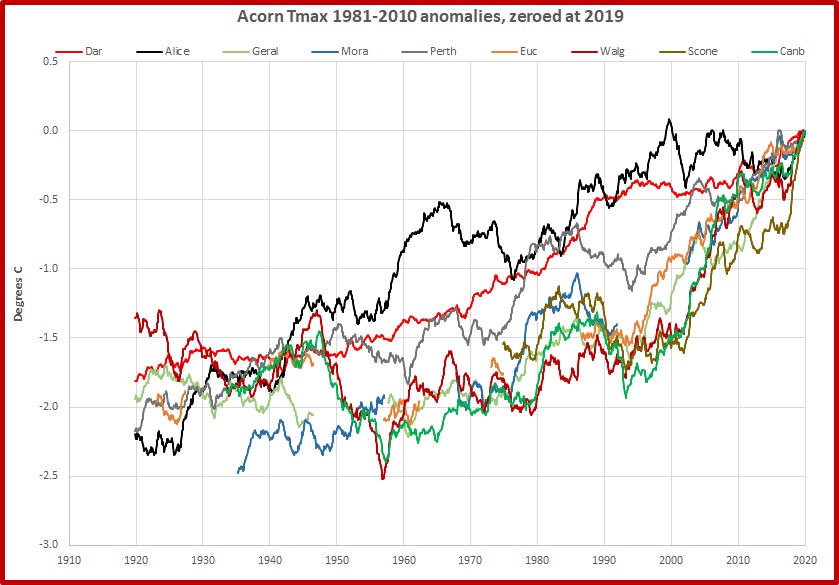We have seen in Parts 1 and 2 that every extra year of annual data can decrease the temperature trend at a weather station by from -0.02 to -0.03℃ per decade, and that less than half (47% actually) of Australia’s weather stations used for climate analysis have data from 1910, and three of them have insufficient data to calculate trends.
Figure 1 shows a map of non-urban Acorn stations with enough data to calculate trends, at 1910. The others I have blanked out.
Figure 1: Acorn stations with data for 1910
The network is very sparse. To estimate a national temperature for 1910 enormous weighting must be given to the values of a few remote stations like Alice Springs, Boulia and Kalgoorlie, so we hope they got the adjustments right! Unfortunately, in 2015 I found adjustments at Kalgoorlie and Alice Springs were very problemmatic.
The Bureau explains the process of calculating average temperatures here.
Figure 2 shows the BOM map of trends from 1910 to 2020:
Figure 2: Australian Tmean trends 1910-2020
Note that there a few “bullseyes” which surround stations whose temperature trends are out of phase with areas around them- e.g. Boulia is warmer, Marble Bar is cooler.
Now here is a paradox. As the years go by and more stations have data available, the area weighting for each station will decrease, however trends at the newer stations will show increased warming compared with the older ones. However they will also have more variability. This will result in oddities as I shall show, and reveals something of the difficulties with the BOM methods.
Figure 2 is a plot of mean temperature from 1970 to 2020.
Figure 2: Australian Tmean 1970-2020
The Acorn 2 trend is now +0.23℃ per decade or +2.3℃ per 100 years- a full degree more than the trend from 1910.
Now let’s look at the trend map for 1970 to2020:
Figure 3: Australian Tmean trends 1970-2020
Note the little “bullseye” around Victoria River Downs, the little “balloon” around Halls Creek to the south-west of VRD, and the little surge to the south-southwest of VRD of 0.05 to 0.1℃ per decade. Note also that north-eastern Arnhem Land, with no stations, has a warmer pocket. Figure 4 is the BOM data for VRD.
Figure 4: Annual mean temperature at Victoria River Downs
VRD opened in 1965 and has too much data missing for BOM to calculate a trend. The area weighting algorithm still gives it a cooling trend of between minus 0.05 and 0℃ per decade (Figure 3). Que?
With more than 27% of data missing I wouldn’t calculate a trend either, but with only six of 43 years missing I can calculate a trend from 1978:
Figure 5: Annual mean temperature at Victoria River Downs
The trend is -0.09℃ per decade, which is a bit more cooling than the trend map (Figure 3) shows. Now let’s look at trends from 1980 to 2020.
Figure 6: Australian Tmean trends 1980-2020
There are more bullseyes, and I have shown temperature trends for some- Carnarvon, Meekatharra, Forrest, Thargomindah, and Gayndah. But remember Figure 3’s little surge to the SSW? It now has its own bullseye, and that is Rabbit Flat.
Figure 7: Annual mean temperature at Rabbit Flat
Rabbit Flat opened in 1970 and has a trend of +0.08℃ per decade, which agrees with the trend map in Figure 3. Now from 1980:
Figure 8: Annual mean temperature at Rabbit Flat
What a difference a few years make in a short timeseries. The trend of -0.06℃ per decade also agrees with the 1980-2020 trend map.
However, just 328km away Halls Creek shows a warming trend of +0.17C per decade from 1980 – 2020:
Figure 9: Annual mean temperature at Halls Creek 1980-2020
But from 1970 to 2020 Halls Ck is warmer still at +0.19C per decade:
Figure 10: Annual mean temperature at Halls Creek 1970-2020
And at Tennant Creek 441km away the 1970-2020 trend is +0.19C per decade:
Figure 11: Annual mean temperature at Tennant Creek 1970-2020
From 1980 it is +0.06C per decade.
Figure 12: Annual mean temperature at Tennant Creek 1980-2020
Temperatures are trending in different directions and wildly different rates at the closest stations: they can’t all be right!
The method of drawing trend maps is to use anomalies of temperatures of all years of all stations whether or not an individual trend can be calculated, then calculate a gridded average, and from that calculate trends, then spread those trends hundreds of kilometres in every direction- even across the Gulf of Carpentaria from Horn Island to Arnhem Land, as seen in Figures 3 and 6- averaged with the trends propagated by other stations. If a site has data missing, the grid is infilled with the weighted data from other sites.
In recent decades this causes great variability because of the short records, which leads to grave doubts about the reliability of some records. Further back in time, there is less variability because there are more stations, and the longer records smooth and decrease the trends- however the weighting has to be much greater because of the large areas with no data at all for many years.
The problem is: we can have either a long record, or an accurate record, but not both.
This leads to the obvious conclusion:
The official temperature record since 1910 is just a guesstimate.


